Detailed Management and Operations Report: M&S Case Study, University
VerifiedAdded on 2020/06/06
|14
|3936
|47
Report
AI Summary
This report analyzes the management and operations of Marks & Spencer (M&S), examining its organizational structure, leadership styles, and operational functions. The report delves into the roles of managers and leaders, differentiating between them and exploring how they impact the organization. It covers various management theories, including contingency theory, system theory, and chaos theory, and their applications in supporting growth and sustainable performance. The report also explores M&S's retail operations, key operational functions, and the impact of external factors on decision-making. Finally, it evaluates operational efficiencies and provides recommendations for future improvements, offering a comprehensive overview of M&S's management and operational strategies.
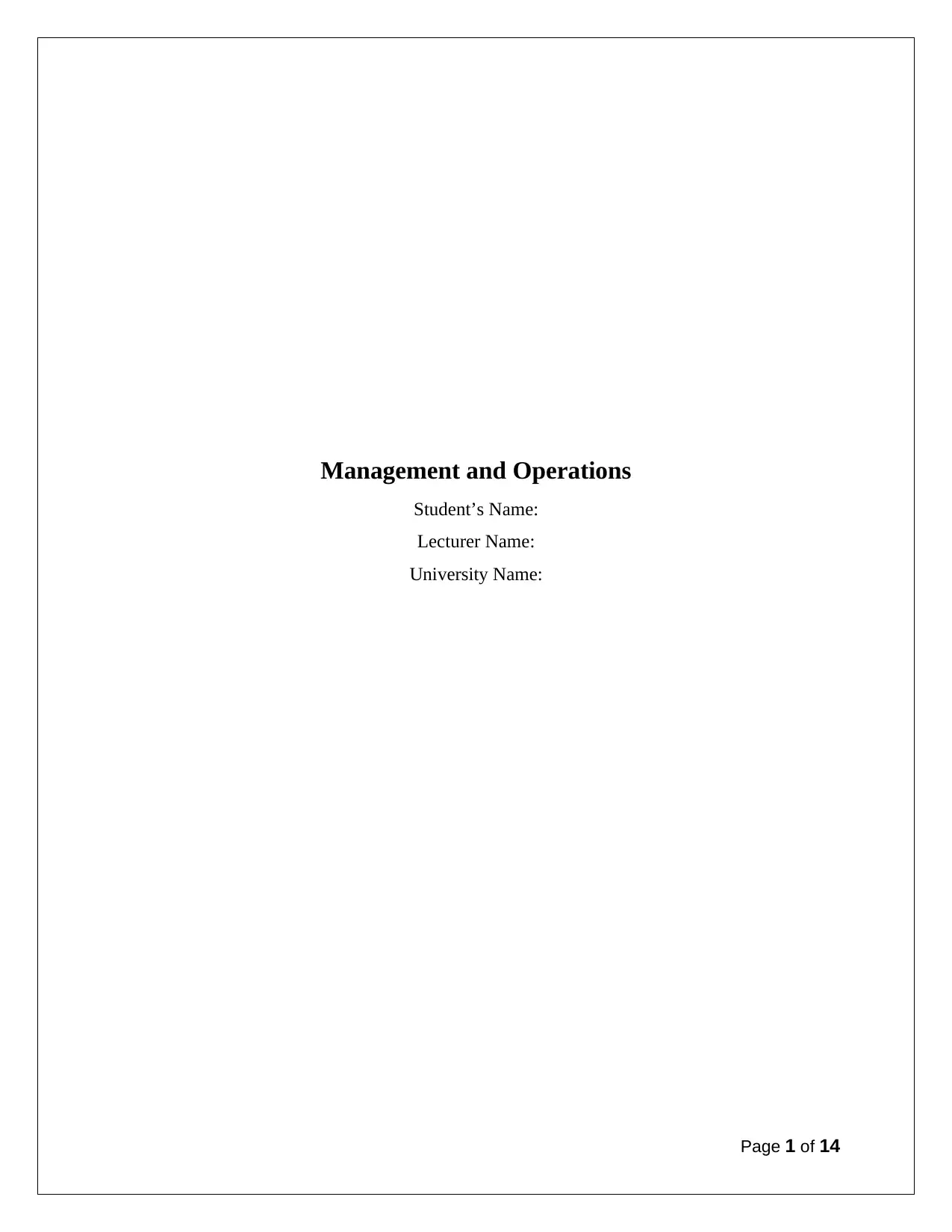
Management and Operations
Student’s Name:
Lecturer Name:
University Name:
Page 1 of 14
Student’s Name:
Lecturer Name:
University Name:
Page 1 of 14
Paraphrase This Document
Need a fresh take? Get an instant paraphrase of this document with our AI Paraphraser
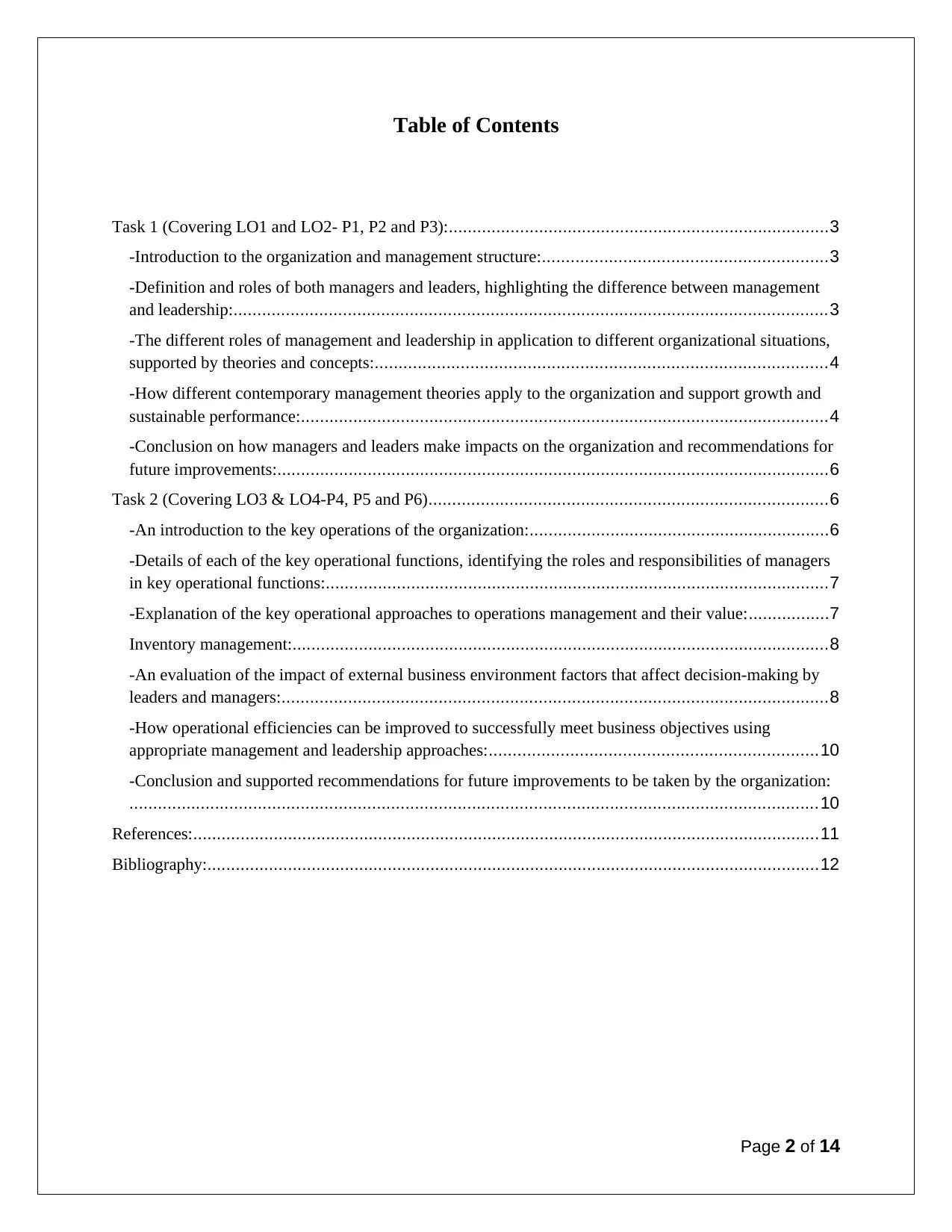
Table of Contents
Task 1 (Covering LO1 and LO2- P1, P2 and P3):................................................................................3
-Introduction to the organization and management structure:............................................................3
-Definition and roles of both managers and leaders, highlighting the difference between management
and leadership:.............................................................................................................................3
-The different roles of management and leadership in application to different organizational situations,
supported by theories and concepts:...............................................................................................4
-How different contemporary management theories apply to the organization and support growth and
sustainable performance:...............................................................................................................4
-Conclusion on how managers and leaders make impacts on the organization and recommendations for
future improvements:....................................................................................................................6
Task 2 (Covering LO3 & LO4-P4, P5 and P6)....................................................................................6
-An introduction to the key operations of the organization:...............................................................6
-Details of each of the key operational functions, identifying the roles and responsibilities of managers
in key operational functions:..........................................................................................................7
-Explanation of the key operational approaches to operations management and their value:.................7
Inventory management:.................................................................................................................8
-An evaluation of the impact of external business environment factors that affect decision-making by
leaders and managers:...................................................................................................................8
-How operational efficiencies can be improved to successfully meet business objectives using
appropriate management and leadership approaches:.....................................................................10
-Conclusion and supported recommendations for future improvements to be taken by the organization:
.................................................................................................................................................10
References:....................................................................................................................................11
Bibliography:.................................................................................................................................12
Page 2 of 14
Task 1 (Covering LO1 and LO2- P1, P2 and P3):................................................................................3
-Introduction to the organization and management structure:............................................................3
-Definition and roles of both managers and leaders, highlighting the difference between management
and leadership:.............................................................................................................................3
-The different roles of management and leadership in application to different organizational situations,
supported by theories and concepts:...............................................................................................4
-How different contemporary management theories apply to the organization and support growth and
sustainable performance:...............................................................................................................4
-Conclusion on how managers and leaders make impacts on the organization and recommendations for
future improvements:....................................................................................................................6
Task 2 (Covering LO3 & LO4-P4, P5 and P6)....................................................................................6
-An introduction to the key operations of the organization:...............................................................6
-Details of each of the key operational functions, identifying the roles and responsibilities of managers
in key operational functions:..........................................................................................................7
-Explanation of the key operational approaches to operations management and their value:.................7
Inventory management:.................................................................................................................8
-An evaluation of the impact of external business environment factors that affect decision-making by
leaders and managers:...................................................................................................................8
-How operational efficiencies can be improved to successfully meet business objectives using
appropriate management and leadership approaches:.....................................................................10
-Conclusion and supported recommendations for future improvements to be taken by the organization:
.................................................................................................................................................10
References:....................................................................................................................................11
Bibliography:.................................................................................................................................12
Page 2 of 14
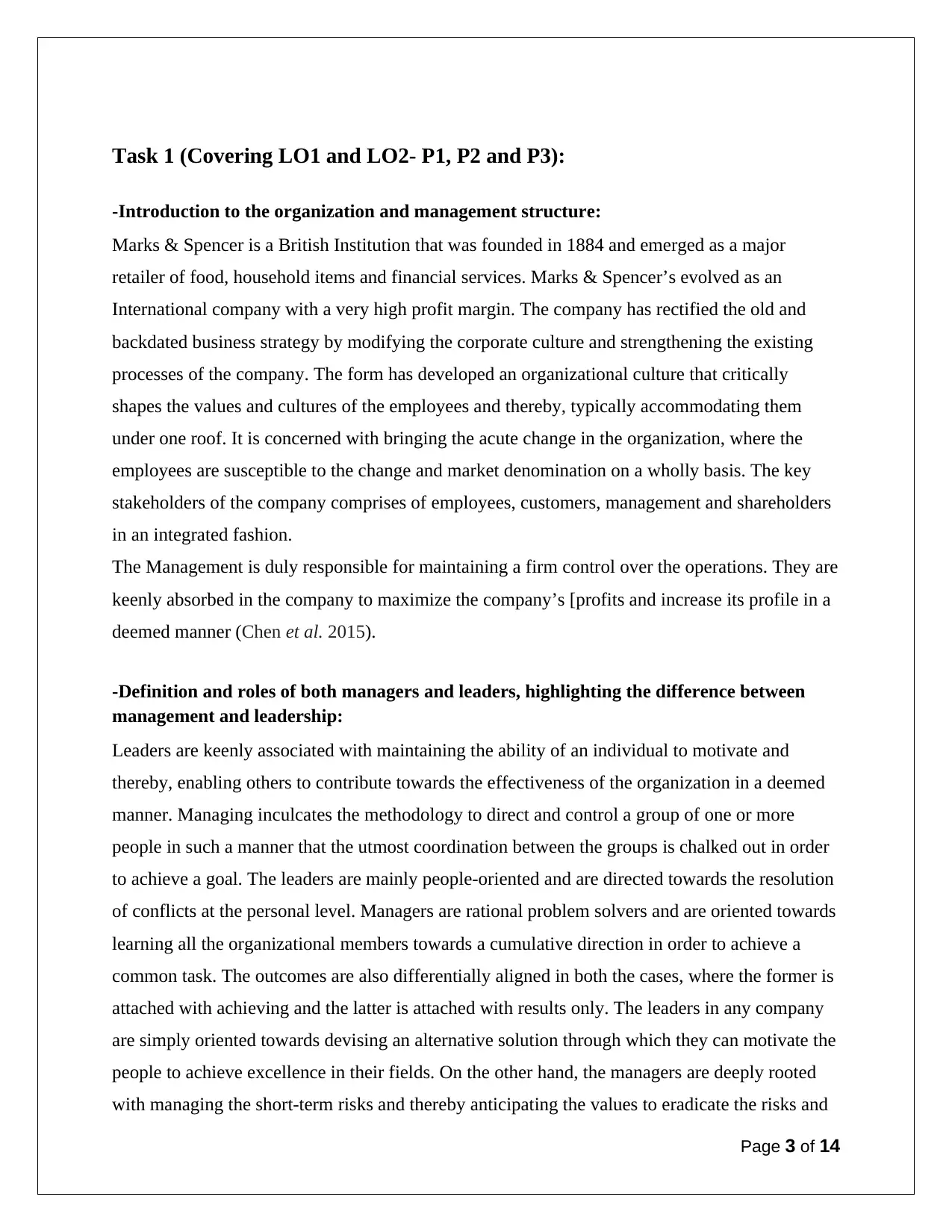
Task 1 (Covering LO1 and LO2- P1, P2 and P3):
-Introduction to the organization and management structure:
Marks & Spencer is a British Institution that was founded in 1884 and emerged as a major
retailer of food, household items and financial services. Marks & Spencer’s evolved as an
International company with a very high profit margin. The company has rectified the old and
backdated business strategy by modifying the corporate culture and strengthening the existing
processes of the company. The form has developed an organizational culture that critically
shapes the values and cultures of the employees and thereby, typically accommodating them
under one roof. It is concerned with bringing the acute change in the organization, where the
employees are susceptible to the change and market denomination on a wholly basis. The key
stakeholders of the company comprises of employees, customers, management and shareholders
in an integrated fashion.
The Management is duly responsible for maintaining a firm control over the operations. They are
keenly absorbed in the company to maximize the company’s [profits and increase its profile in a
deemed manner (Chen et al. 2015).
-Definition and roles of both managers and leaders, highlighting the difference between
management and leadership:
Leaders are keenly associated with maintaining the ability of an individual to motivate and
thereby, enabling others to contribute towards the effectiveness of the organization in a deemed
manner. Managing inculcates the methodology to direct and control a group of one or more
people in such a manner that the utmost coordination between the groups is chalked out in order
to achieve a goal. The leaders are mainly people-oriented and are directed towards the resolution
of conflicts at the personal level. Managers are rational problem solvers and are oriented towards
learning all the organizational members towards a cumulative direction in order to achieve a
common task. The outcomes are also differentially aligned in both the cases, where the former is
attached with achieving and the latter is attached with results only. The leaders in any company
are simply oriented towards devising an alternative solution through which they can motivate the
people to achieve excellence in their fields. On the other hand, the managers are deeply rooted
with managing the short-term risks and thereby anticipating the values to eradicate the risks and
Page 3 of 14
-Introduction to the organization and management structure:
Marks & Spencer is a British Institution that was founded in 1884 and emerged as a major
retailer of food, household items and financial services. Marks & Spencer’s evolved as an
International company with a very high profit margin. The company has rectified the old and
backdated business strategy by modifying the corporate culture and strengthening the existing
processes of the company. The form has developed an organizational culture that critically
shapes the values and cultures of the employees and thereby, typically accommodating them
under one roof. It is concerned with bringing the acute change in the organization, where the
employees are susceptible to the change and market denomination on a wholly basis. The key
stakeholders of the company comprises of employees, customers, management and shareholders
in an integrated fashion.
The Management is duly responsible for maintaining a firm control over the operations. They are
keenly absorbed in the company to maximize the company’s [profits and increase its profile in a
deemed manner (Chen et al. 2015).
-Definition and roles of both managers and leaders, highlighting the difference between
management and leadership:
Leaders are keenly associated with maintaining the ability of an individual to motivate and
thereby, enabling others to contribute towards the effectiveness of the organization in a deemed
manner. Managing inculcates the methodology to direct and control a group of one or more
people in such a manner that the utmost coordination between the groups is chalked out in order
to achieve a goal. The leaders are mainly people-oriented and are directed towards the resolution
of conflicts at the personal level. Managers are rational problem solvers and are oriented towards
learning all the organizational members towards a cumulative direction in order to achieve a
common task. The outcomes are also differentially aligned in both the cases, where the former is
attached with achieving and the latter is attached with results only. The leaders in any company
are simply oriented towards devising an alternative solution through which they can motivate the
people to achieve excellence in their fields. On the other hand, the managers are deeply rooted
with managing the short-term risks and thereby anticipating the values to eradicate the risks and
Page 3 of 14
⊘ This is a preview!⊘
Do you want full access?
Subscribe today to unlock all pages.

Trusted by 1+ million students worldwide
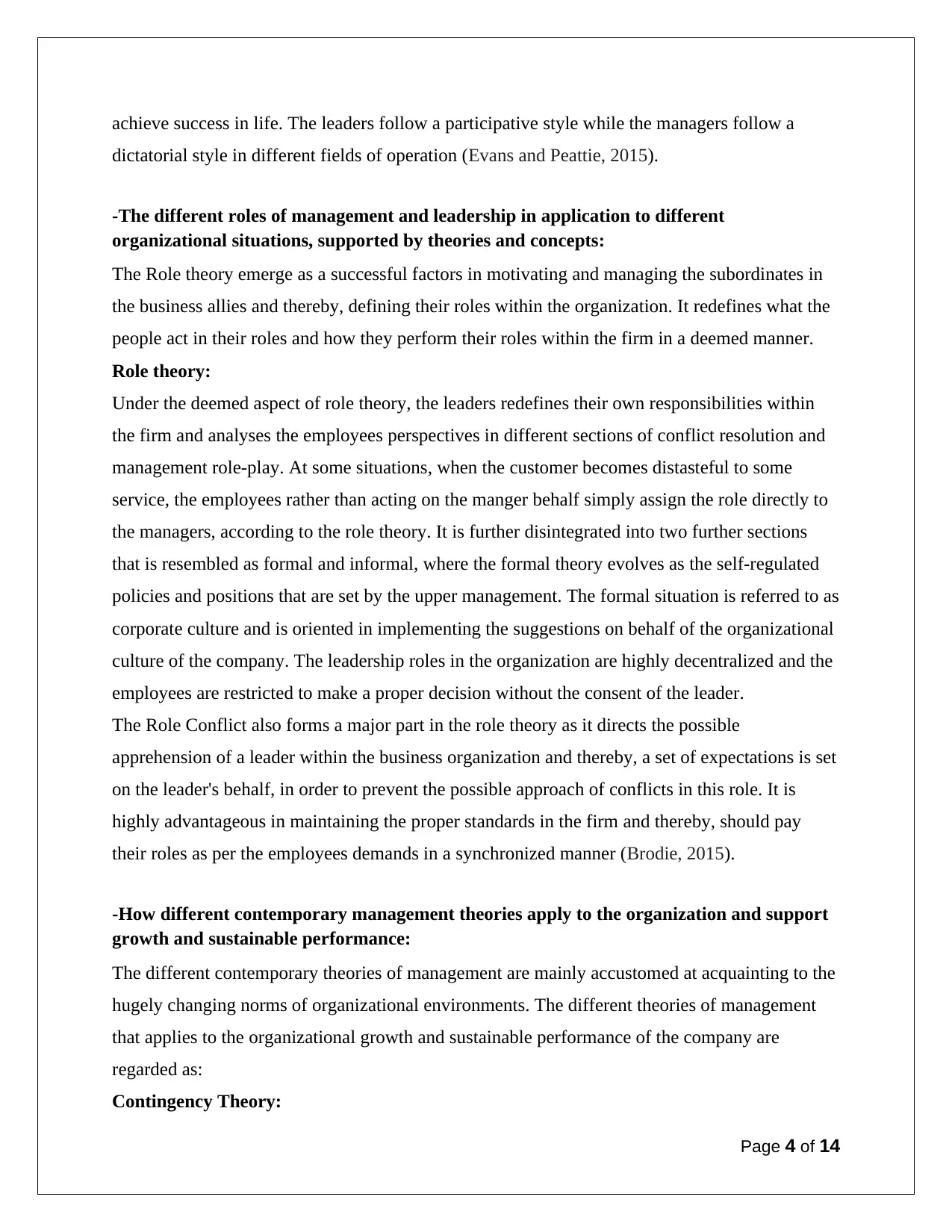
achieve success in life. The leaders follow a participative style while the managers follow a
dictatorial style in different fields of operation (Evans and Peattie, 2015).
-The different roles of management and leadership in application to different
organizational situations, supported by theories and concepts:
The Role theory emerge as a successful factors in motivating and managing the subordinates in
the business allies and thereby, defining their roles within the organization. It redefines what the
people act in their roles and how they perform their roles within the firm in a deemed manner.
Role theory:
Under the deemed aspect of role theory, the leaders redefines their own responsibilities within
the firm and analyses the employees perspectives in different sections of conflict resolution and
management role-play. At some situations, when the customer becomes distasteful to some
service, the employees rather than acting on the manger behalf simply assign the role directly to
the managers, according to the role theory. It is further disintegrated into two further sections
that is resembled as formal and informal, where the formal theory evolves as the self-regulated
policies and positions that are set by the upper management. The formal situation is referred to as
corporate culture and is oriented in implementing the suggestions on behalf of the organizational
culture of the company. The leadership roles in the organization are highly decentralized and the
employees are restricted to make a proper decision without the consent of the leader.
The Role Conflict also forms a major part in the role theory as it directs the possible
apprehension of a leader within the business organization and thereby, a set of expectations is set
on the leader's behalf, in order to prevent the possible approach of conflicts in this role. It is
highly advantageous in maintaining the proper standards in the firm and thereby, should pay
their roles as per the employees demands in a synchronized manner (Brodie, 2015).
-How different contemporary management theories apply to the organization and support
growth and sustainable performance:
The different contemporary theories of management are mainly accustomed at acquainting to the
hugely changing norms of organizational environments. The different theories of management
that applies to the organizational growth and sustainable performance of the company are
regarded as:
Contingency Theory:
Page 4 of 14
dictatorial style in different fields of operation (Evans and Peattie, 2015).
-The different roles of management and leadership in application to different
organizational situations, supported by theories and concepts:
The Role theory emerge as a successful factors in motivating and managing the subordinates in
the business allies and thereby, defining their roles within the organization. It redefines what the
people act in their roles and how they perform their roles within the firm in a deemed manner.
Role theory:
Under the deemed aspect of role theory, the leaders redefines their own responsibilities within
the firm and analyses the employees perspectives in different sections of conflict resolution and
management role-play. At some situations, when the customer becomes distasteful to some
service, the employees rather than acting on the manger behalf simply assign the role directly to
the managers, according to the role theory. It is further disintegrated into two further sections
that is resembled as formal and informal, where the formal theory evolves as the self-regulated
policies and positions that are set by the upper management. The formal situation is referred to as
corporate culture and is oriented in implementing the suggestions on behalf of the organizational
culture of the company. The leadership roles in the organization are highly decentralized and the
employees are restricted to make a proper decision without the consent of the leader.
The Role Conflict also forms a major part in the role theory as it directs the possible
apprehension of a leader within the business organization and thereby, a set of expectations is set
on the leader's behalf, in order to prevent the possible approach of conflicts in this role. It is
highly advantageous in maintaining the proper standards in the firm and thereby, should pay
their roles as per the employees demands in a synchronized manner (Brodie, 2015).
-How different contemporary management theories apply to the organization and support
growth and sustainable performance:
The different contemporary theories of management are mainly accustomed at acquainting to the
hugely changing norms of organizational environments. The different theories of management
that applies to the organizational growth and sustainable performance of the company are
regarded as:
Contingency Theory:
Page 4 of 14
Paraphrase This Document
Need a fresh take? Get an instant paraphrase of this document with our AI Paraphraser
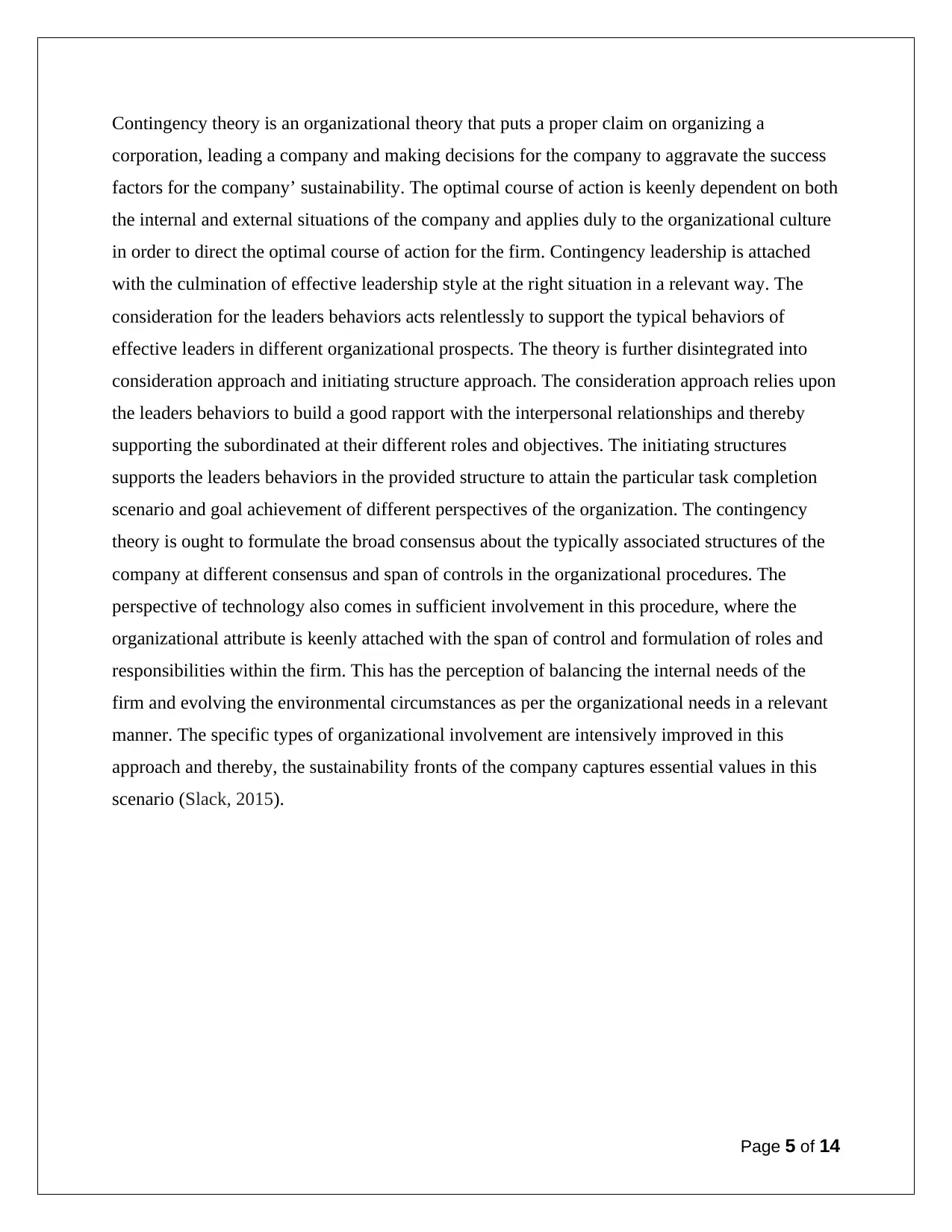
Contingency theory is an organizational theory that puts a proper claim on organizing a
corporation, leading a company and making decisions for the company to aggravate the success
factors for the company’ sustainability. The optimal course of action is keenly dependent on both
the internal and external situations of the company and applies duly to the organizational culture
in order to direct the optimal course of action for the firm. Contingency leadership is attached
with the culmination of effective leadership style at the right situation in a relevant way. The
consideration for the leaders behaviors acts relentlessly to support the typical behaviors of
effective leaders in different organizational prospects. The theory is further disintegrated into
consideration approach and initiating structure approach. The consideration approach relies upon
the leaders behaviors to build a good rapport with the interpersonal relationships and thereby
supporting the subordinated at their different roles and objectives. The initiating structures
supports the leaders behaviors in the provided structure to attain the particular task completion
scenario and goal achievement of different perspectives of the organization. The contingency
theory is ought to formulate the broad consensus about the typically associated structures of the
company at different consensus and span of controls in the organizational procedures. The
perspective of technology also comes in sufficient involvement in this procedure, where the
organizational attribute is keenly attached with the span of control and formulation of roles and
responsibilities within the firm. This has the perception of balancing the internal needs of the
firm and evolving the environmental circumstances as per the organizational needs in a relevant
manner. The specific types of organizational involvement are intensively improved in this
approach and thereby, the sustainability fronts of the company captures essential values in this
scenario (Slack, 2015).
Page 5 of 14
corporation, leading a company and making decisions for the company to aggravate the success
factors for the company’ sustainability. The optimal course of action is keenly dependent on both
the internal and external situations of the company and applies duly to the organizational culture
in order to direct the optimal course of action for the firm. Contingency leadership is attached
with the culmination of effective leadership style at the right situation in a relevant way. The
consideration for the leaders behaviors acts relentlessly to support the typical behaviors of
effective leaders in different organizational prospects. The theory is further disintegrated into
consideration approach and initiating structure approach. The consideration approach relies upon
the leaders behaviors to build a good rapport with the interpersonal relationships and thereby
supporting the subordinated at their different roles and objectives. The initiating structures
supports the leaders behaviors in the provided structure to attain the particular task completion
scenario and goal achievement of different perspectives of the organization. The contingency
theory is ought to formulate the broad consensus about the typically associated structures of the
company at different consensus and span of controls in the organizational procedures. The
perspective of technology also comes in sufficient involvement in this procedure, where the
organizational attribute is keenly attached with the span of control and formulation of roles and
responsibilities within the firm. This has the perception of balancing the internal needs of the
firm and evolving the environmental circumstances as per the organizational needs in a relevant
manner. The specific types of organizational involvement are intensively improved in this
approach and thereby, the sustainability fronts of the company captures essential values in this
scenario (Slack, 2015).
Page 5 of 14
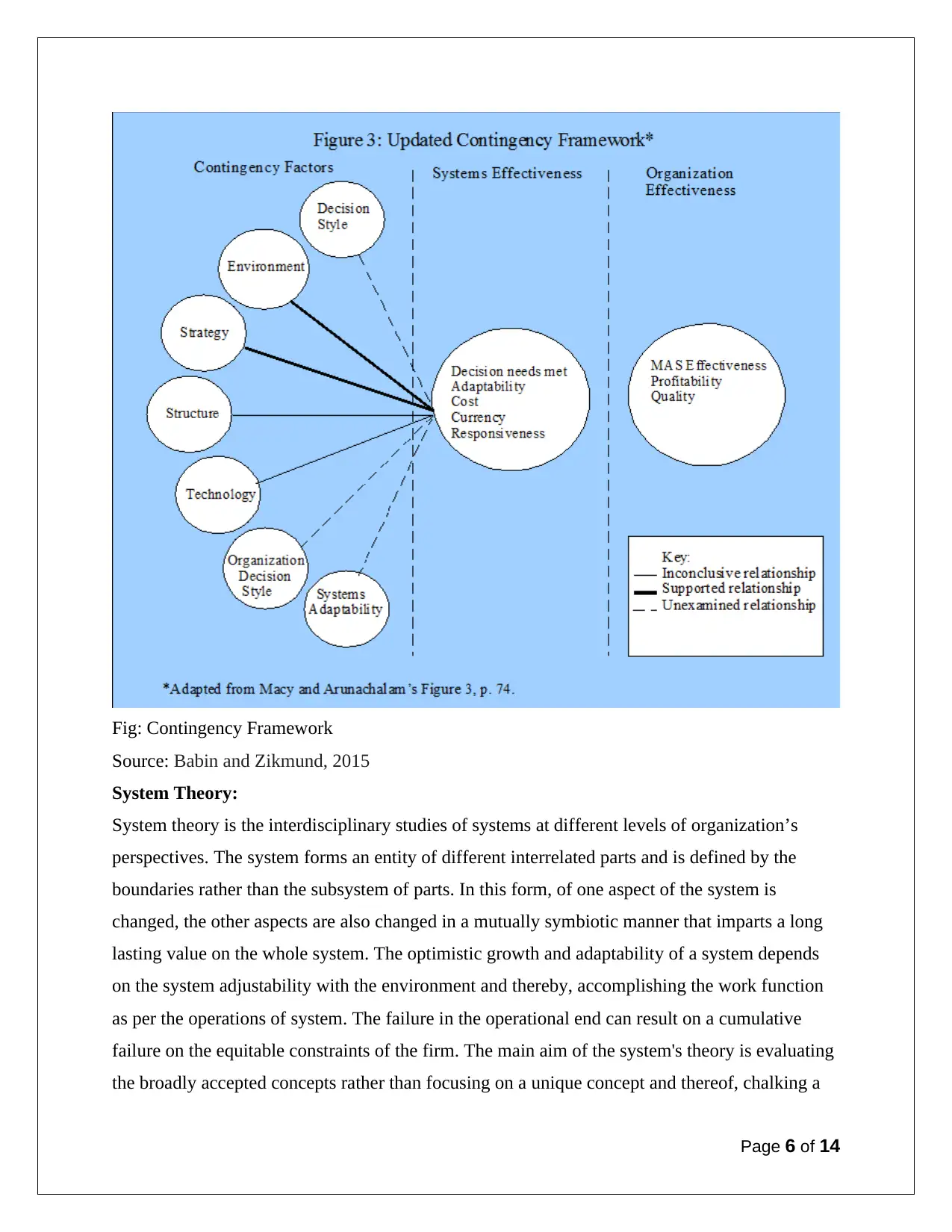
Fig: Contingency Framework
Source: Babin and Zikmund, 2015
System Theory:
System theory is the interdisciplinary studies of systems at different levels of organization’s
perspectives. The system forms an entity of different interrelated parts and is defined by the
boundaries rather than the subsystem of parts. In this form, of one aspect of the system is
changed, the other aspects are also changed in a mutually symbiotic manner that imparts a long
lasting value on the whole system. The optimistic growth and adaptability of a system depends
on the system adjustability with the environment and thereby, accomplishing the work function
as per the operations of system. The failure in the operational end can result on a cumulative
failure on the equitable constraints of the firm. The main aim of the system's theory is evaluating
the broadly accepted concepts rather than focusing on a unique concept and thereof, chalking a
Page 6 of 14
Source: Babin and Zikmund, 2015
System Theory:
System theory is the interdisciplinary studies of systems at different levels of organization’s
perspectives. The system forms an entity of different interrelated parts and is defined by the
boundaries rather than the subsystem of parts. In this form, of one aspect of the system is
changed, the other aspects are also changed in a mutually symbiotic manner that imparts a long
lasting value on the whole system. The optimistic growth and adaptability of a system depends
on the system adjustability with the environment and thereby, accomplishing the work function
as per the operations of system. The failure in the operational end can result on a cumulative
failure on the equitable constraints of the firm. The main aim of the system's theory is evaluating
the broadly accepted concepts rather than focusing on a unique concept and thereof, chalking a
Page 6 of 14
⊘ This is a preview!⊘
Do you want full access?
Subscribe today to unlock all pages.

Trusted by 1+ million students worldwide
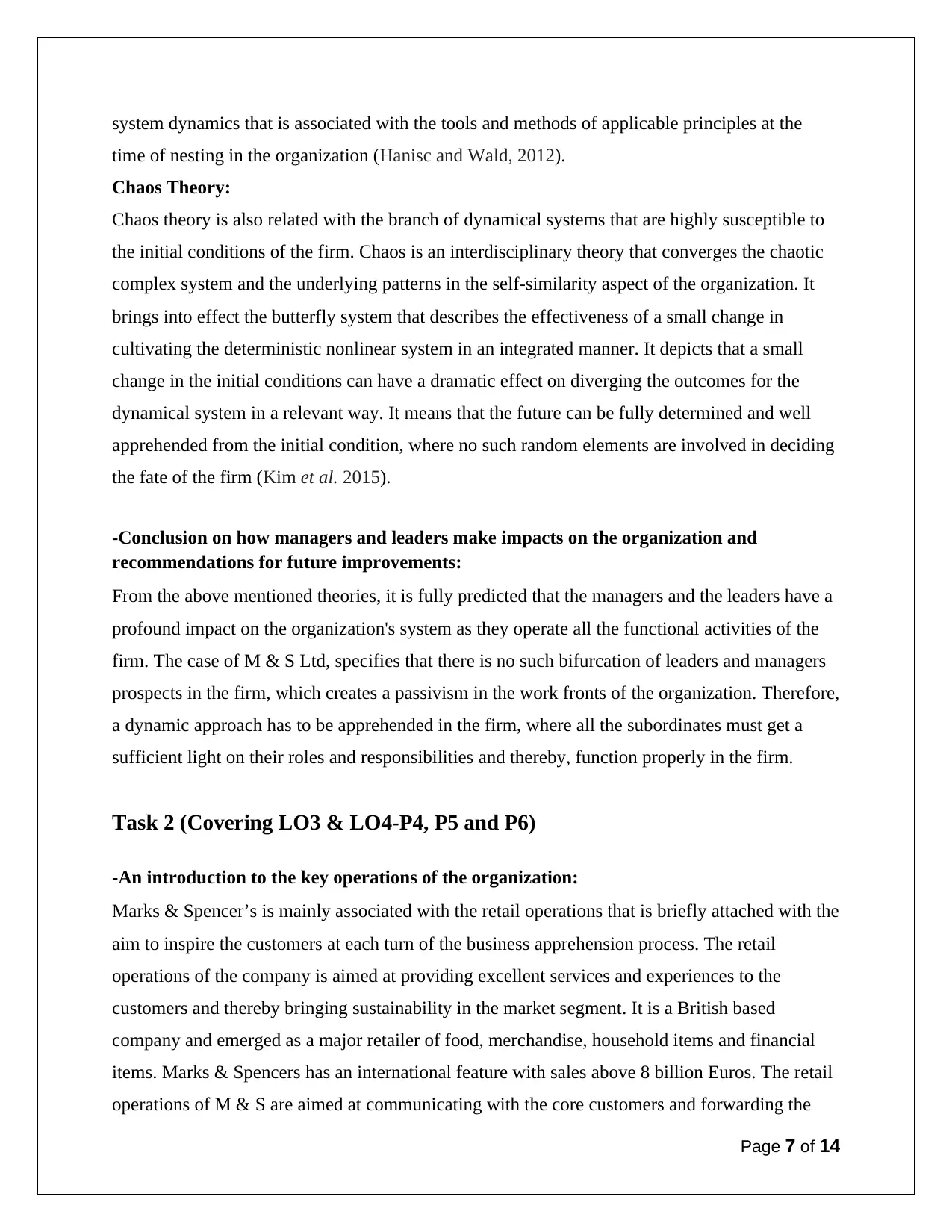
system dynamics that is associated with the tools and methods of applicable principles at the
time of nesting in the organization (Hanisc and Wald, 2012).
Chaos Theory:
Chaos theory is also related with the branch of dynamical systems that are highly susceptible to
the initial conditions of the firm. Chaos is an interdisciplinary theory that converges the chaotic
complex system and the underlying patterns in the self-similarity aspect of the organization. It
brings into effect the butterfly system that describes the effectiveness of a small change in
cultivating the deterministic nonlinear system in an integrated manner. It depicts that a small
change in the initial conditions can have a dramatic effect on diverging the outcomes for the
dynamical system in a relevant way. It means that the future can be fully determined and well
apprehended from the initial condition, where no such random elements are involved in deciding
the fate of the firm (Kim et al. 2015).
-Conclusion on how managers and leaders make impacts on the organization and
recommendations for future improvements:
From the above mentioned theories, it is fully predicted that the managers and the leaders have a
profound impact on the organization's system as they operate all the functional activities of the
firm. The case of M & S Ltd, specifies that there is no such bifurcation of leaders and managers
prospects in the firm, which creates a passivism in the work fronts of the organization. Therefore,
a dynamic approach has to be apprehended in the firm, where all the subordinates must get a
sufficient light on their roles and responsibilities and thereby, function properly in the firm.
Task 2 (Covering LO3 & LO4-P4, P5 and P6)
-An introduction to the key operations of the organization:
Marks & Spencer’s is mainly associated with the retail operations that is briefly attached with the
aim to inspire the customers at each turn of the business apprehension process. The retail
operations of the company is aimed at providing excellent services and experiences to the
customers and thereby bringing sustainability in the market segment. It is a British based
company and emerged as a major retailer of food, merchandise, household items and financial
items. Marks & Spencers has an international feature with sales above 8 billion Euros. The retail
operations of M & S are aimed at communicating with the core customers and forwarding the
Page 7 of 14
time of nesting in the organization (Hanisc and Wald, 2012).
Chaos Theory:
Chaos theory is also related with the branch of dynamical systems that are highly susceptible to
the initial conditions of the firm. Chaos is an interdisciplinary theory that converges the chaotic
complex system and the underlying patterns in the self-similarity aspect of the organization. It
brings into effect the butterfly system that describes the effectiveness of a small change in
cultivating the deterministic nonlinear system in an integrated manner. It depicts that a small
change in the initial conditions can have a dramatic effect on diverging the outcomes for the
dynamical system in a relevant way. It means that the future can be fully determined and well
apprehended from the initial condition, where no such random elements are involved in deciding
the fate of the firm (Kim et al. 2015).
-Conclusion on how managers and leaders make impacts on the organization and
recommendations for future improvements:
From the above mentioned theories, it is fully predicted that the managers and the leaders have a
profound impact on the organization's system as they operate all the functional activities of the
firm. The case of M & S Ltd, specifies that there is no such bifurcation of leaders and managers
prospects in the firm, which creates a passivism in the work fronts of the organization. Therefore,
a dynamic approach has to be apprehended in the firm, where all the subordinates must get a
sufficient light on their roles and responsibilities and thereby, function properly in the firm.
Task 2 (Covering LO3 & LO4-P4, P5 and P6)
-An introduction to the key operations of the organization:
Marks & Spencer’s is mainly associated with the retail operations that is briefly attached with the
aim to inspire the customers at each turn of the business apprehension process. The retail
operations of the company is aimed at providing excellent services and experiences to the
customers and thereby bringing sustainability in the market segment. It is a British based
company and emerged as a major retailer of food, merchandise, household items and financial
items. Marks & Spencers has an international feature with sales above 8 billion Euros. The retail
operations of M & S are aimed at communicating with the core customers and forwarding the
Page 7 of 14
Paraphrase This Document
Need a fresh take? Get an instant paraphrase of this document with our AI Paraphraser
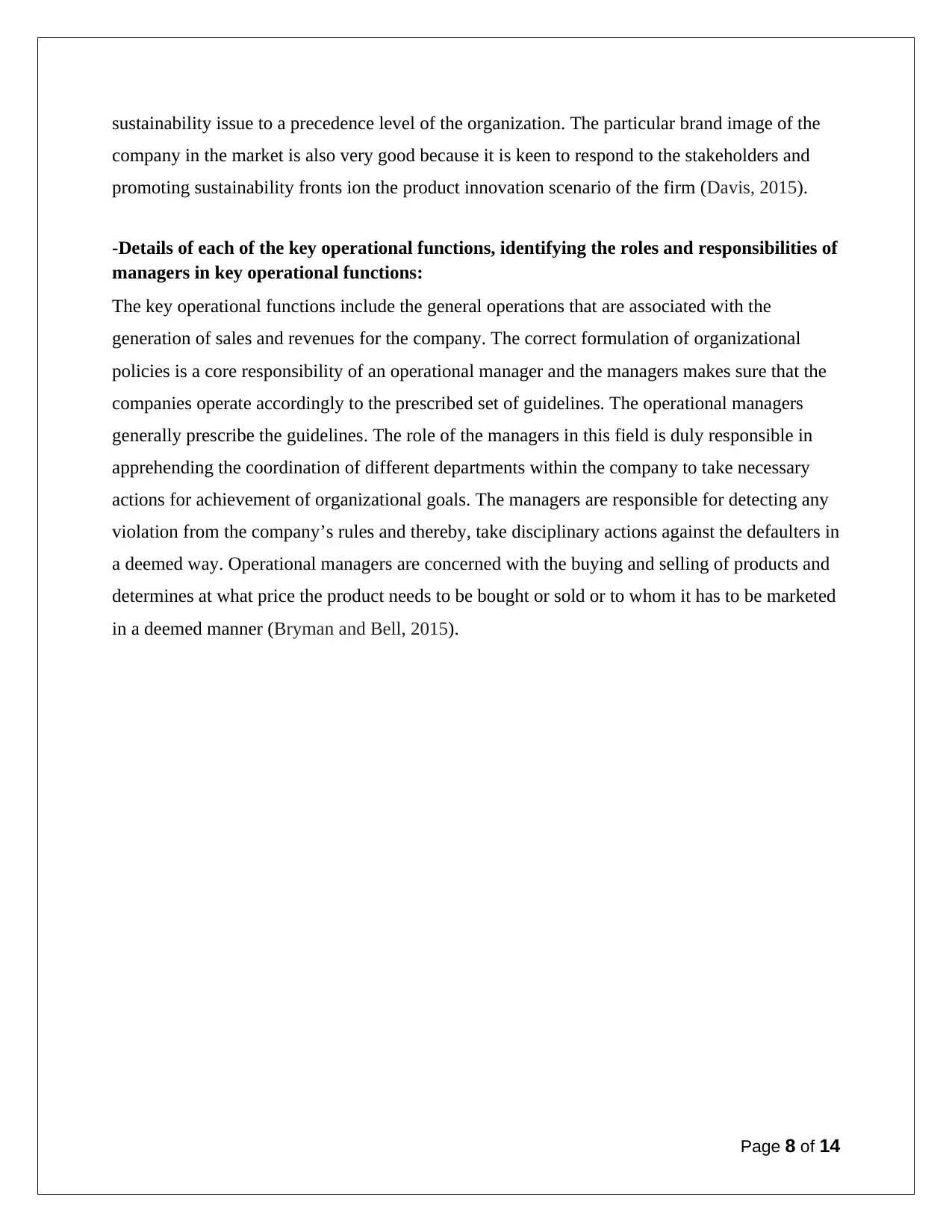
sustainability issue to a precedence level of the organization. The particular brand image of the
company in the market is also very good because it is keen to respond to the stakeholders and
promoting sustainability fronts ion the product innovation scenario of the firm (Davis, 2015).
-Details of each of the key operational functions, identifying the roles and responsibilities of
managers in key operational functions:
The key operational functions include the general operations that are associated with the
generation of sales and revenues for the company. The correct formulation of organizational
policies is a core responsibility of an operational manager and the managers makes sure that the
companies operate accordingly to the prescribed set of guidelines. The operational managers
generally prescribe the guidelines. The role of the managers in this field is duly responsible in
apprehending the coordination of different departments within the company to take necessary
actions for achievement of organizational goals. The managers are responsible for detecting any
violation from the company’s rules and thereby, take disciplinary actions against the defaulters in
a deemed way. Operational managers are concerned with the buying and selling of products and
determines at what price the product needs to be bought or sold or to whom it has to be marketed
in a deemed manner (Bryman and Bell, 2015).
Page 8 of 14
company in the market is also very good because it is keen to respond to the stakeholders and
promoting sustainability fronts ion the product innovation scenario of the firm (Davis, 2015).
-Details of each of the key operational functions, identifying the roles and responsibilities of
managers in key operational functions:
The key operational functions include the general operations that are associated with the
generation of sales and revenues for the company. The correct formulation of organizational
policies is a core responsibility of an operational manager and the managers makes sure that the
companies operate accordingly to the prescribed set of guidelines. The operational managers
generally prescribe the guidelines. The role of the managers in this field is duly responsible in
apprehending the coordination of different departments within the company to take necessary
actions for achievement of organizational goals. The managers are responsible for detecting any
violation from the company’s rules and thereby, take disciplinary actions against the defaulters in
a deemed way. Operational managers are concerned with the buying and selling of products and
determines at what price the product needs to be bought or sold or to whom it has to be marketed
in a deemed manner (Bryman and Bell, 2015).
Page 8 of 14
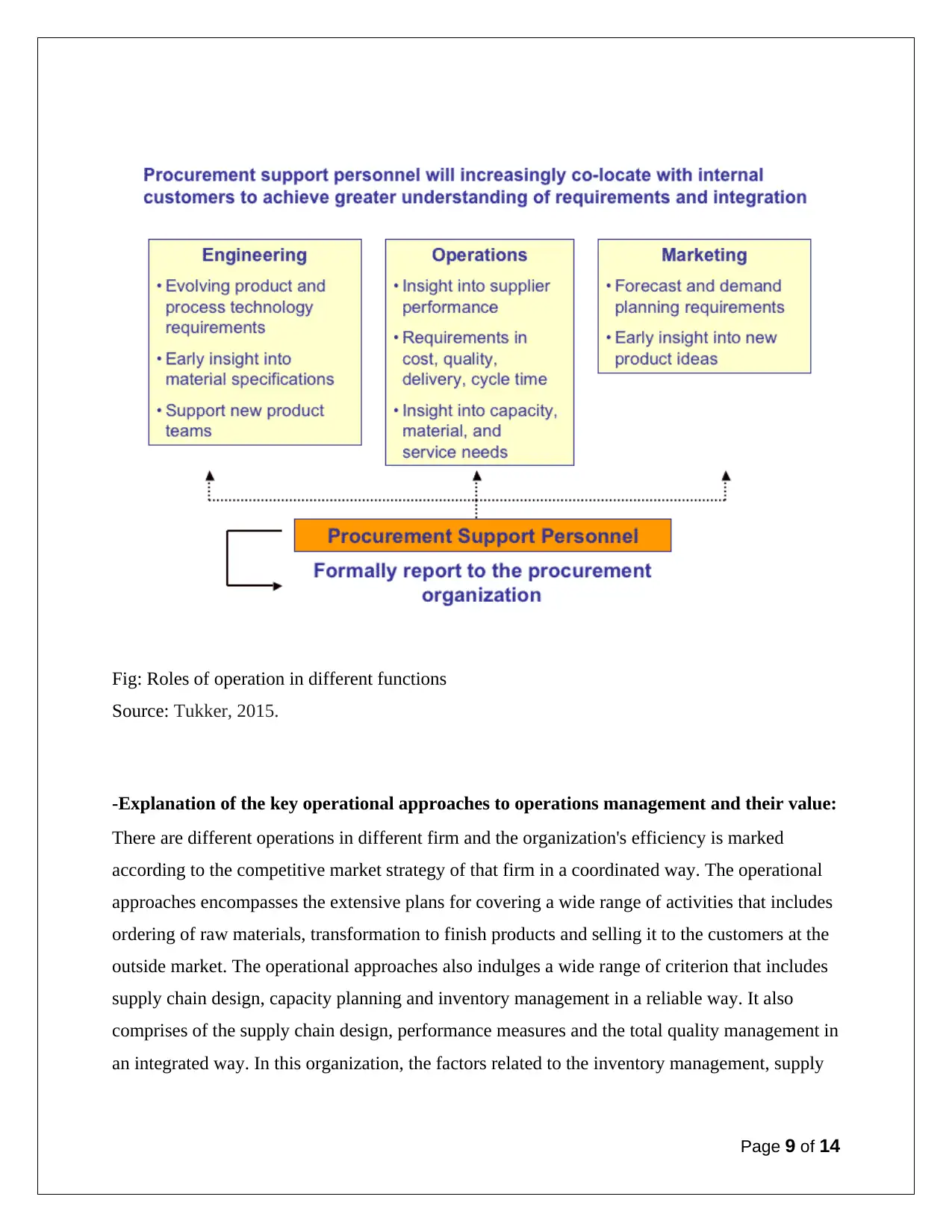
Fig: Roles of operation in different functions
Source: Tukker, 2015.
-Explanation of the key operational approaches to operations management and their value:
There are different operations in different firm and the organization's efficiency is marked
according to the competitive market strategy of that firm in a coordinated way. The operational
approaches encompasses the extensive plans for covering a wide range of activities that includes
ordering of raw materials, transformation to finish products and selling it to the customers at the
outside market. The operational approaches also indulges a wide range of criterion that includes
supply chain design, capacity planning and inventory management in a reliable way. It also
comprises of the supply chain design, performance measures and the total quality management in
an integrated way. In this organization, the factors related to the inventory management, supply
Page 9 of 14
Source: Tukker, 2015.
-Explanation of the key operational approaches to operations management and their value:
There are different operations in different firm and the organization's efficiency is marked
according to the competitive market strategy of that firm in a coordinated way. The operational
approaches encompasses the extensive plans for covering a wide range of activities that includes
ordering of raw materials, transformation to finish products and selling it to the customers at the
outside market. The operational approaches also indulges a wide range of criterion that includes
supply chain design, capacity planning and inventory management in a reliable way. It also
comprises of the supply chain design, performance measures and the total quality management in
an integrated way. In this organization, the factors related to the inventory management, supply
Page 9 of 14
⊘ This is a preview!⊘
Do you want full access?
Subscribe today to unlock all pages.

Trusted by 1+ million students worldwide
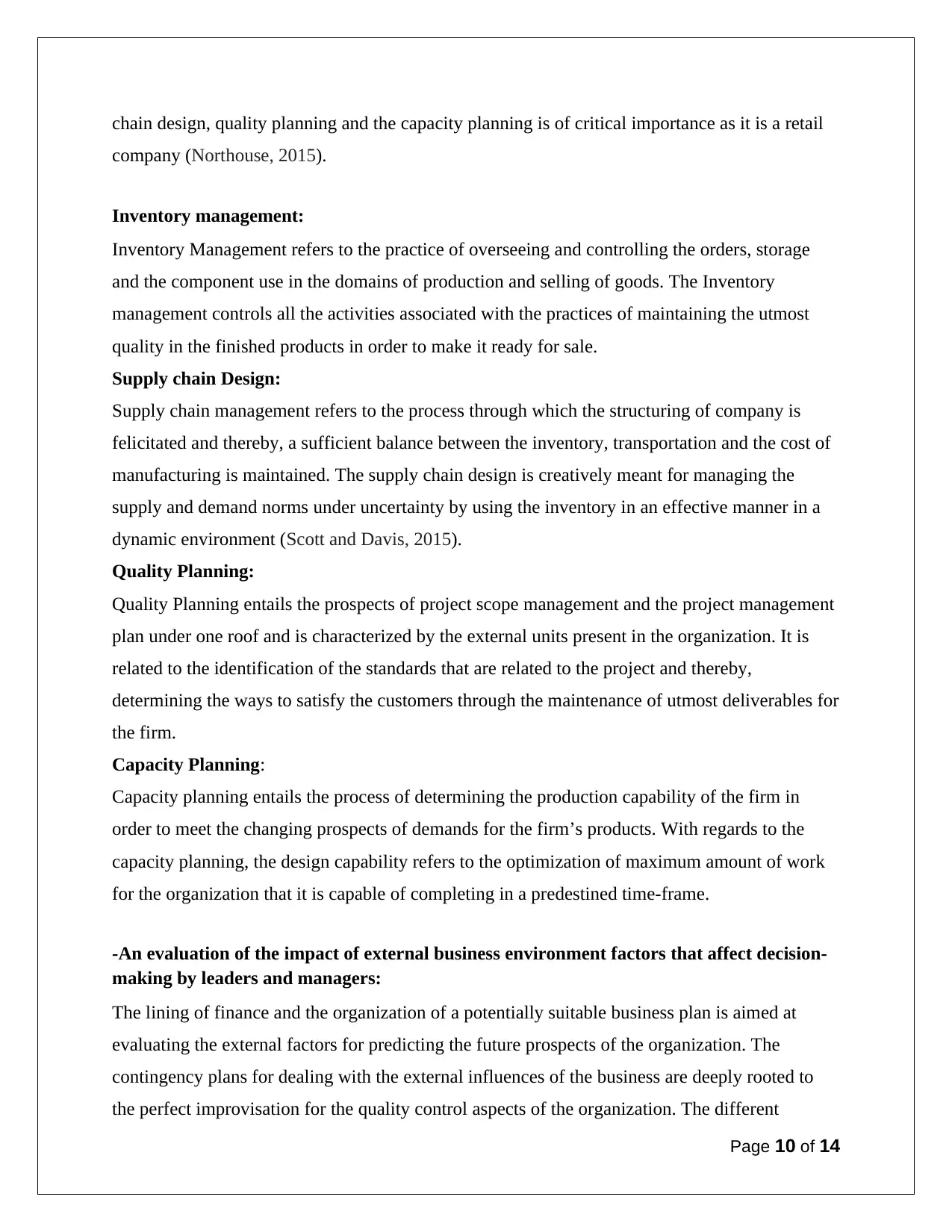
chain design, quality planning and the capacity planning is of critical importance as it is a retail
company (Northouse, 2015).
Inventory management:
Inventory Management refers to the practice of overseeing and controlling the orders, storage
and the component use in the domains of production and selling of goods. The Inventory
management controls all the activities associated with the practices of maintaining the utmost
quality in the finished products in order to make it ready for sale.
Supply chain Design:
Supply chain management refers to the process through which the structuring of company is
felicitated and thereby, a sufficient balance between the inventory, transportation and the cost of
manufacturing is maintained. The supply chain design is creatively meant for managing the
supply and demand norms under uncertainty by using the inventory in an effective manner in a
dynamic environment (Scott and Davis, 2015).
Quality Planning:
Quality Planning entails the prospects of project scope management and the project management
plan under one roof and is characterized by the external units present in the organization. It is
related to the identification of the standards that are related to the project and thereby,
determining the ways to satisfy the customers through the maintenance of utmost deliverables for
the firm.
Capacity Planning:
Capacity planning entails the process of determining the production capability of the firm in
order to meet the changing prospects of demands for the firm’s products. With regards to the
capacity planning, the design capability refers to the optimization of maximum amount of work
for the organization that it is capable of completing in a predestined time-frame.
-An evaluation of the impact of external business environment factors that affect decision-
making by leaders and managers:
The lining of finance and the organization of a potentially suitable business plan is aimed at
evaluating the external factors for predicting the future prospects of the organization. The
contingency plans for dealing with the external influences of the business are deeply rooted to
the perfect improvisation for the quality control aspects of the organization. The different
Page 10 of 14
company (Northouse, 2015).
Inventory management:
Inventory Management refers to the practice of overseeing and controlling the orders, storage
and the component use in the domains of production and selling of goods. The Inventory
management controls all the activities associated with the practices of maintaining the utmost
quality in the finished products in order to make it ready for sale.
Supply chain Design:
Supply chain management refers to the process through which the structuring of company is
felicitated and thereby, a sufficient balance between the inventory, transportation and the cost of
manufacturing is maintained. The supply chain design is creatively meant for managing the
supply and demand norms under uncertainty by using the inventory in an effective manner in a
dynamic environment (Scott and Davis, 2015).
Quality Planning:
Quality Planning entails the prospects of project scope management and the project management
plan under one roof and is characterized by the external units present in the organization. It is
related to the identification of the standards that are related to the project and thereby,
determining the ways to satisfy the customers through the maintenance of utmost deliverables for
the firm.
Capacity Planning:
Capacity planning entails the process of determining the production capability of the firm in
order to meet the changing prospects of demands for the firm’s products. With regards to the
capacity planning, the design capability refers to the optimization of maximum amount of work
for the organization that it is capable of completing in a predestined time-frame.
-An evaluation of the impact of external business environment factors that affect decision-
making by leaders and managers:
The lining of finance and the organization of a potentially suitable business plan is aimed at
evaluating the external factors for predicting the future prospects of the organization. The
contingency plans for dealing with the external influences of the business are deeply rooted to
the perfect improvisation for the quality control aspects of the organization. The different
Page 10 of 14
Paraphrase This Document
Need a fresh take? Get an instant paraphrase of this document with our AI Paraphraser
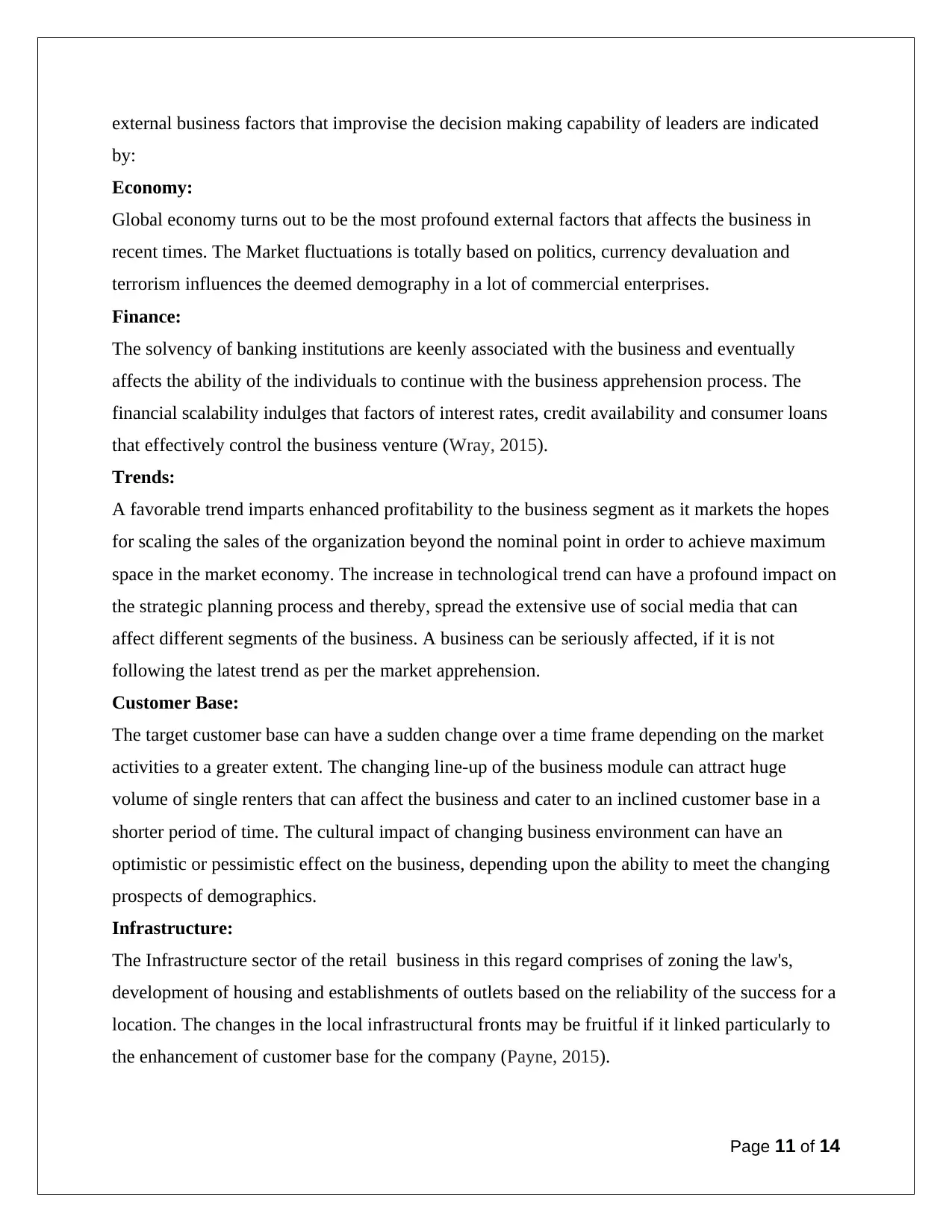
external business factors that improvise the decision making capability of leaders are indicated
by:
Economy:
Global economy turns out to be the most profound external factors that affects the business in
recent times. The Market fluctuations is totally based on politics, currency devaluation and
terrorism influences the deemed demography in a lot of commercial enterprises.
Finance:
The solvency of banking institutions are keenly associated with the business and eventually
affects the ability of the individuals to continue with the business apprehension process. The
financial scalability indulges that factors of interest rates, credit availability and consumer loans
that effectively control the business venture (Wray, 2015).
Trends:
A favorable trend imparts enhanced profitability to the business segment as it markets the hopes
for scaling the sales of the organization beyond the nominal point in order to achieve maximum
space in the market economy. The increase in technological trend can have a profound impact on
the strategic planning process and thereby, spread the extensive use of social media that can
affect different segments of the business. A business can be seriously affected, if it is not
following the latest trend as per the market apprehension.
Customer Base:
The target customer base can have a sudden change over a time frame depending on the market
activities to a greater extent. The changing line-up of the business module can attract huge
volume of single renters that can affect the business and cater to an inclined customer base in a
shorter period of time. The cultural impact of changing business environment can have an
optimistic or pessimistic effect on the business, depending upon the ability to meet the changing
prospects of demographics.
Infrastructure:
The Infrastructure sector of the retail business in this regard comprises of zoning the law's,
development of housing and establishments of outlets based on the reliability of the success for a
location. The changes in the local infrastructural fronts may be fruitful if it linked particularly to
the enhancement of customer base for the company (Payne, 2015).
Page 11 of 14
by:
Economy:
Global economy turns out to be the most profound external factors that affects the business in
recent times. The Market fluctuations is totally based on politics, currency devaluation and
terrorism influences the deemed demography in a lot of commercial enterprises.
Finance:
The solvency of banking institutions are keenly associated with the business and eventually
affects the ability of the individuals to continue with the business apprehension process. The
financial scalability indulges that factors of interest rates, credit availability and consumer loans
that effectively control the business venture (Wray, 2015).
Trends:
A favorable trend imparts enhanced profitability to the business segment as it markets the hopes
for scaling the sales of the organization beyond the nominal point in order to achieve maximum
space in the market economy. The increase in technological trend can have a profound impact on
the strategic planning process and thereby, spread the extensive use of social media that can
affect different segments of the business. A business can be seriously affected, if it is not
following the latest trend as per the market apprehension.
Customer Base:
The target customer base can have a sudden change over a time frame depending on the market
activities to a greater extent. The changing line-up of the business module can attract huge
volume of single renters that can affect the business and cater to an inclined customer base in a
shorter period of time. The cultural impact of changing business environment can have an
optimistic or pessimistic effect on the business, depending upon the ability to meet the changing
prospects of demographics.
Infrastructure:
The Infrastructure sector of the retail business in this regard comprises of zoning the law's,
development of housing and establishments of outlets based on the reliability of the success for a
location. The changes in the local infrastructural fronts may be fruitful if it linked particularly to
the enhancement of customer base for the company (Payne, 2015).
Page 11 of 14
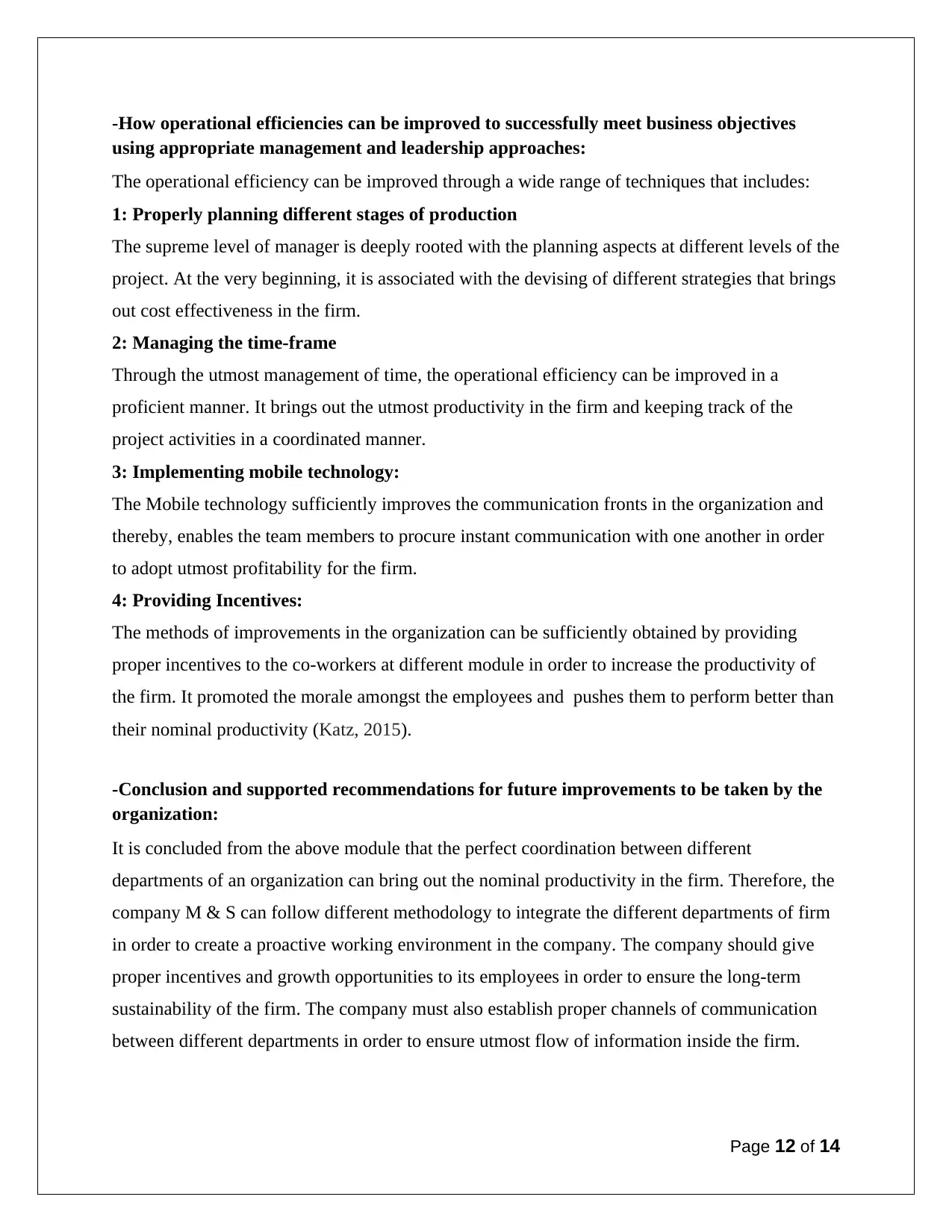
-How operational efficiencies can be improved to successfully meet business objectives
using appropriate management and leadership approaches:
The operational efficiency can be improved through a wide range of techniques that includes:
1: Properly planning different stages of production
The supreme level of manager is deeply rooted with the planning aspects at different levels of the
project. At the very beginning, it is associated with the devising of different strategies that brings
out cost effectiveness in the firm.
2: Managing the time-frame
Through the utmost management of time, the operational efficiency can be improved in a
proficient manner. It brings out the utmost productivity in the firm and keeping track of the
project activities in a coordinated manner.
3: Implementing mobile technology:
The Mobile technology sufficiently improves the communication fronts in the organization and
thereby, enables the team members to procure instant communication with one another in order
to adopt utmost profitability for the firm.
4: Providing Incentives:
The methods of improvements in the organization can be sufficiently obtained by providing
proper incentives to the co-workers at different module in order to increase the productivity of
the firm. It promoted the morale amongst the employees and pushes them to perform better than
their nominal productivity (Katz, 2015).
-Conclusion and supported recommendations for future improvements to be taken by the
organization:
It is concluded from the above module that the perfect coordination between different
departments of an organization can bring out the nominal productivity in the firm. Therefore, the
company M & S can follow different methodology to integrate the different departments of firm
in order to create a proactive working environment in the company. The company should give
proper incentives and growth opportunities to its employees in order to ensure the long-term
sustainability of the firm. The company must also establish proper channels of communication
between different departments in order to ensure utmost flow of information inside the firm.
Page 12 of 14
using appropriate management and leadership approaches:
The operational efficiency can be improved through a wide range of techniques that includes:
1: Properly planning different stages of production
The supreme level of manager is deeply rooted with the planning aspects at different levels of the
project. At the very beginning, it is associated with the devising of different strategies that brings
out cost effectiveness in the firm.
2: Managing the time-frame
Through the utmost management of time, the operational efficiency can be improved in a
proficient manner. It brings out the utmost productivity in the firm and keeping track of the
project activities in a coordinated manner.
3: Implementing mobile technology:
The Mobile technology sufficiently improves the communication fronts in the organization and
thereby, enables the team members to procure instant communication with one another in order
to adopt utmost profitability for the firm.
4: Providing Incentives:
The methods of improvements in the organization can be sufficiently obtained by providing
proper incentives to the co-workers at different module in order to increase the productivity of
the firm. It promoted the morale amongst the employees and pushes them to perform better than
their nominal productivity (Katz, 2015).
-Conclusion and supported recommendations for future improvements to be taken by the
organization:
It is concluded from the above module that the perfect coordination between different
departments of an organization can bring out the nominal productivity in the firm. Therefore, the
company M & S can follow different methodology to integrate the different departments of firm
in order to create a proactive working environment in the company. The company should give
proper incentives and growth opportunities to its employees in order to ensure the long-term
sustainability of the firm. The company must also establish proper channels of communication
between different departments in order to ensure utmost flow of information inside the firm.
Page 12 of 14
⊘ This is a preview!⊘
Do you want full access?
Subscribe today to unlock all pages.

Trusted by 1+ million students worldwide
1 out of 14
Related Documents
Your All-in-One AI-Powered Toolkit for Academic Success.
+13062052269
info@desklib.com
Available 24*7 on WhatsApp / Email
![[object Object]](/_next/static/media/star-bottom.7253800d.svg)
Unlock your academic potential
Copyright © 2020–2025 A2Z Services. All Rights Reserved. Developed and managed by ZUCOL.





